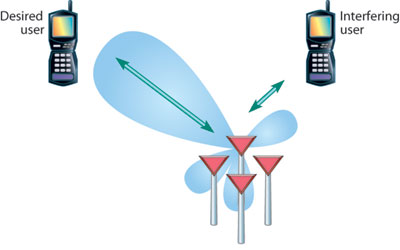What is VSWR and Return Loss
What is VSWR and Return Loss?
Wireless communication systems require the proper integration of several components. For example, antennas are connected to the transmitter/receiver, as well as switching and signal processing equipment by means of a coaxial cable. It is important that these components are “matched” from an RF standpoint, otherwise, reflections occur. Reflections affect the overall performance of our system. If the level of reflections becomes excessive, the quality and performance of our system are greatly degraded.
Thus, a wireless communications system is similar to connecting several garden hoses together with a sprinkler. If the hoses and sprinkler are properly matched, the sprinkler distributes water to the outside environment, covering the desired area. If not, the sprinkler either dribbles water out to the outside environment (loss of signal power) or doesn’t work at all. Although this example is rather simplistic in form, we get the idea!
Now the question comes to; how can we tell if reflections occur or matching is not proper in our system? The right way to know this is by measuring the Voltage Standing Wave Ratio (VSWR) or Return Loss (RL in dB) of the components, individually and of the system as a whole.
VSWR and RL are measures of how much energy is reflected from a device’s input or output. VSWR and RL denote the same factor and are related mathematically.
The relationships between an antenna’s input impedance, Z, its reflection coefficient, Γ, and VSWR and RL are:
Comparison of VSWR and Return Loss
|
VSWR |
Return Loss (dB) | Description |
|
1.0:1 |
∞ | Ideal case, Perfect Match. Only in theory. |
|
1.5:1 |
14 |
Good Match, Much Less Reflection (again, this is design specific!) |
|
2.0:1 |
9.5 |
Poor Match, Poor reflections, some mismatch exists |
|
10.0:1 |
2 |
Very Bad Match, Large amount of reflections. Something is terribly wrong with the system. |
| ∞:1 |
0 |
We should look got another line of work! |
Table-1
Table-1 compares various values of VSWR and Return Loss. It is merely an example to illustrate that VSWR measurements are unit-less and are measured in terms of X: 1, wherein the lower the value of “X”, the better the measurement. Conversely, Return Loss measurements are measured in terms of dB and the higher the return loss value, the better the measurement.
Table-2 below shows some typical values of VSWR and RL of various components in a cable and antenna system. These are not any company-specific specifications, just a means to identify the common values within the system.
Typical VSWR and Return Loss Values of Cables and Antennas
|
VSWR |
Return Loss (dB) | Component |
| 1.5:1 | 14 |
Antenna |
|
1.22:1 |
20 |
Lightning Arrestor |
|
1.06:1 |
30 |
Connector |
| 1.01:1 | 45 |
Cables |
Table-2
Measuring VSWR/ RL Values of Cable and Antenna System at Site
Now let us focus on the problems of VSWR/RL, associated with cables and antennas at the site. Normally it has been observed that of all the problems of VSWR reported at the site:
- 60% are connector related
- 20% are cable related
- 5% are antenna related
Probable causes for most of the cable and antenna problems are many like connector transitions, jumpers, kinks in the cable or moisture intrusion. The best way to measure the VSWR/Return Loss at the site is to conduct a system RL/VSWR sweep, with the help of instruments like Agilent or Anritsu’s Site Master or BTS Master. Since each site is configured differently, it is natural to get separate sweep values at different sites.
Typical values of good RL values for a site vary between 14 – 20 dB, depending upon the configuration of the system.
The best method for fault finding of a cable and antenna system, in terms of VSWR/RL is to use DTF or Distance to Fault measurements to calculate and compare different RL/ VSWR values.
The DTF measurement displays return loss (or VSWR) values versus distance. If the frequency measurements fail or indicate a problem in the system, then the DTF measurement can be used to identify and pinpoint the exact location of the problem. The DTF measurement shows the return loss value of all the individual components including connector pairs and cable components.
To measure the distance of a cable, DTF measurements can be made with an open or a short connected at the end of the cable. The peak indicating the end of the cable should be between 0 dB and 5 dB.
An open or short should not be used when DTF is used for troubleshooting because the open/short will reflect everything and the true value of a connector might be misinterpreted and a good connector could look like a failing connector.
A 50Ω load is the best termination for troubleshooting DTF problems because it will be 50Ω over the entire frequency range. The antenna can also be used as a terminating device but the impedance of the antenna will change over different frequencies because most antennas are only designed to have 15 dB or better return loss in the pass band of the antenna.
DTF measurement is a frequency domain measurement and the data is transformed to the time domain using mathematics. The distance information is obtained by analyzing how much the phase is changing when the system is swept in the frequency domain.
In all, there are six measurements that provide the information required to verify the integrity of a cable and antenna system:
- Cable Loss (Insertion Loss) of the transmission line
- With an open or short connected
- DTF-VSWR / RL of the transmission line
- With an open or short connected.
- RL / VSWR of the transmission line
- With a 50 Ohm termination connected
- DTF-VSWR/RL of the transmission line
- With a 50 Ohm termination connected.
- RL / VSWR of the transmission line
- With Antenna connected
- DTF-VSWR/ RL of the transmission line
- With an Antenna connected.
Before starting a line sweep for measuring VSWR/ RL using DTF measurements, the following three things must be crystal clear:
- Frequency Range — Can be obtained from the system specs and we must ensure that the antenna matches the frequency band.
- Cable Types – This can be obtained from the system specs and our cables used must be matching with the frequency of usage.
- Distance of Cable run – Normally not found in system specs, but it is essential. For greenhorns in frequency sweeping, always advisable to draw out the schematic of the system prior to conducting DTF measurements.
Points of Interest:
- The accuracy of DTF measurements depends on a lot of factors like bandwidth of measurements, calibration of equipment, quality of cables used for measurement, the relative phase of transmission lines etc.
- Usually, RL/VSWR amplitude values of antennas will be much better in DTF measurements than actual measurements.
- Although the DTF measurements are not the most accurate method to calculate VSWR or RL, it is a great asset for comparing subsequent measurements with the baseline data during site commissioning.
Article Submitted By Mr. Sibasis Das

Sibasis Das is Sales Manager for South Asia region at iBwave Solutions Inc. He is Technical Sales professional with 12+ years of experience in Technical Sales, Business Development, Product Engineering, and Project Management, with special domain knowledge of Software Sales, Radio Frequency ( RF ) and Microwave Products and Services


